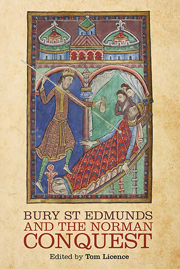Book contents
- Frontmatter
- Contents
- LIST OF ILLUSTRATIONS
- LIST OF MUSIC EXAMPLES
- LIST OF CONTRIBUTORS
- ACKNOWLEDGMENTS
- LIST OF ABBREVIATIONS
- Introduction
- 1 The Abbey and the Norman Conquest an Unusual Case?
- 2 Charters and Influences from Saint-Denis c. 1000–1070
- 3 The Abbey's Armoury of Charters
- 4 The Women of Bury St Edmunds
- 5 Baldwin's Church and the Effects of the Conquest
- 6 New Light on the Life and Work of Herman the Archdeacon
- 7 The Cult of St Edmund
- 8 St Edmund Between Liturgy and Hagiography
- 9 Books and their Use Across the Conquest
- 10 An Eleventh-Century Bury Medical Manuscript
- 11 Medicine at Bury in the Time of Abbot Baldwin
- 12 Medicine After Baldwin: The Evidence of BL, Royal 12. C. xxiv
- Index
12 - Medicine After Baldwin: The Evidence of BL, Royal 12. C. xxiv
Published online by Cambridge University Press: 05 August 2014
- Frontmatter
- Contents
- LIST OF ILLUSTRATIONS
- LIST OF MUSIC EXAMPLES
- LIST OF CONTRIBUTORS
- ACKNOWLEDGMENTS
- LIST OF ABBREVIATIONS
- Introduction
- 1 The Abbey and the Norman Conquest an Unusual Case?
- 2 Charters and Influences from Saint-Denis c. 1000–1070
- 3 The Abbey's Armoury of Charters
- 4 The Women of Bury St Edmunds
- 5 Baldwin's Church and the Effects of the Conquest
- 6 New Light on the Life and Work of Herman the Archdeacon
- 7 The Cult of St Edmund
- 8 St Edmund Between Liturgy and Hagiography
- 9 Books and their Use Across the Conquest
- 10 An Eleventh-Century Bury Medical Manuscript
- 11 Medicine at Bury in the Time of Abbot Baldwin
- 12 Medicine After Baldwin: The Evidence of BL, Royal 12. C. xxiv
- Index
Summary
There are three types of epilepsy: analempsia, epilempsia, and catalempsia. Analempsia has that name because it deprives the sacred parts of the head of sensation, and it arises either from neglect of the stomach, or from an excess of food or drink, or from drinking cold things, or from luxury … Epilempsia has that name from seizure of the mind and senses, and when they are besieged the body is also possessed, for it is a serious and slow affliction. Some call this sickness comitialis, others the holy affliction, and the Greeks call it geronoson … Catalempsia is epilepsy accompanied by fever … the sickness of cataleptics starts with the feet or lower legs. When they feel the advancing pain and catarrh, it comes from an excess of blood, or rather, choler ferments in the confines of the stomach, with no natural exit, whence it burdens the head and injures the senses.
This explanation of the causes and effects working within the human body is found in an eleventh-century medical text from Salerno, the Passionarius (‘Book of Diseases’) attributed to the physician Gariopontus. This medical text survives in sixty-five medieval manuscripts, one of which is now London, British Library, MS Royal 12. C. xxiv. Michael Gullick has identified the script of this manuscript as that of an early twelfth-century scribe of Bury St Edmunds, demonstrating that this text was known at Bury in the generation after the physician-abbot Baldwin.
- Type
- Chapter
- Information
- Bury St Edmunds and the Norman Conquest , pp. 247 - 258Publisher: Boydell & BrewerPrint publication year: 2014



